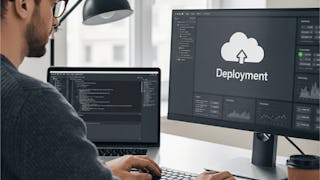In this course, learners will unlock the potential of automation for computer fleet management. This course provides a solid foundation in automation techniques, offering a pathway to becoming a versatile IT professional prepared to launch and support modern cloud based applications and systems. This course covers the art of automating computer deployment and management in a cloud-based environment. Learners will explore Docker and learn container orchestration with Kubernetes. They’ll gain expertise in configuration management tools and techniques, as well as the principles of CI/CD.


Configuration Management and the Cloud
本课程是 Google IT Automation with Python 专业证书 的一部分

顶尖授课教师
120,133 人已注册
包含在  中
中
您将学到什么
Understand the benefits of configuration management and infrastructure as code
Create and maintain containers with Docker and Kubernetes to create efficient and safe application deployment
Automatically deploy new virtual machines running in the Cloud
Deploy changes in a safe manner following CICD principles
您将获得的技能
要了解的详细信息

添加到您的领英档案
16 项作业
了解顶级公司的员工如何掌握热门技能

积累 Cloud Computing 领域的专业知识
- 向行业专家学习新概念
- 获得对主题或工具的基础理解
- 通过实践项目培养工作相关技能
- 通过 Google 获得可共享的职业证书

该课程共有4个模块
In this module, you’ll be introduced to the concept of automation at scale and how it can be successfully achieved. You’ll learn what it means to work at scale and how automation is needed to scale effectively. Next, you’ll be introduced to configuration management. You’ll learn the differences between unmanaged and managed configuration management. Then, you’ll dive into infrastructure as code and learn about the benefits it brings, like making your fleet of nodes more reliable and repeatable. This is a major benefit when managing systems at scale. In the next lesson, you’ll be introduced to Puppet. You’ll learn how to apply basic configuration management and how Puppet agents and masters interact with each other. Next, you’ll do a rundown of Puppet resources and classes. You’ll learn how resources are basic units for modeling your configurations and how classes are a collection of resources used to achieve a single goal. The final lesson will introduce you to the building blocks of domain-specific language. You’ll learn what Puppet facts are and how it uses a program called Facter to analyze, store and gather this information. Your final lesson will cover the driving principles of configuration management. You’ll learn about declarative, procedural, and idempotent principals and how they differ from each other.
涵盖的内容
11个视频10篇阅读材料4个作业1个应用程序项目
In this module, you’ll dive into deploying Puppet on your local machine. Once you’ve completed that task, you’ll start creating and applying Puppet rules, managing resource relationships, and organizing your Puppet modules, which are a collection of manifests and associated data. Next, you’ll learn about Puppet nodes and node definitions and how they’re used to apply rules to your fleet. Then, you’ll dive into the Puppet certificate infrastructure, which explores the logic behind how the server can trust that a client is really who it claims to be. This topic will introduce the concepts of public key infrastructure and secure socket layer, which can ensure the clients can be trusted. Once you’ve understood these concepts, you’ll get to see a Puppet deployment in action! Your final lesson will center on updating, modifying, and testing manifests that you’ve deployed to your fleet. You’ll explore Puppet parser validate commands that will allow you to check the syntax to ensure it's correct. Next, you’ll explore the difference between production and testing environments, and how you can safely roll out changes to the testing environment to catch any errors. You’ll also learn about development environments and how you can siphon part of your fleet to an early-adopters or canary track to roll out changes, modification, or updates to that subset of machines.
涵盖的内容
10个视频10篇阅读材料4个作业1个应用程序项目
In this module, you’ll learn about cloud services and the different types of cloud services, like SaaS, PaaS, and IaaS. Next, you’ll learn about scaling in the cloud and how to modify the capacity of your service. You’ll learn about horizontal and vertical scaling, which then ties into automatic versus manual scaling. Next, you’ll explore how much control you have over your system, depending on whether you choose SaaS, Paas, or IaaS, and assess which one is right for your business. You’ll rundown the options available to migrate your business to the cloud using strategies like lift and shift. In the next lesson, you’ll learn how to manage instances in the cloud by creating one! You’ll explore the different options available, like regions, machine types, and lots more. Then, you’ll look into customizing and templating virtual machines to enable you to deploy them at scale. Our final lesson will explore the concept of automating cloud deployments. You’ll learn about load balancers, which ensure that each node receives a balanced number of requests, as well as autoscaling, which shuts nodes on and off, as needed. Next, you’ll learn about orchestration and how orchestration and automation differ. Last up, you’ll learn about infrastructure as code (IaC), or machine readable configuration files that automate configuration management.
涵盖的内容
13个视频4篇阅读材料4个作业1个应用程序项目
In this module, you’ll learn all about storing data in the cloud. You’ll rundown the different types of storage available, like block storage and object storage, and how they differ. You’ll explore load balancing further and dive into some load balancing techniques, like round-robin DNS and sticky sessions. Next, you’ll dive into change management, including the different ways to test your changes and how to push them. You’ll explore different testing methods, like unit tests and integration tests. You’ll also cover continuous integration, the use of continuous deployment, and how to apply A/B testing. Next up, you’ll look at some errors you might encounter along the way, like quotas or limits, and how best to avoid or prepare for these. In the next lesson, you’ll get an understanding of monitoring and altering, and review some systems that offer it. You’ll then dive into the concept of SLA’s and how to set achievable ones. Next, you’ll look at basic monitoring in GCP, and create altering policies, set up conditions, and choose aggregators to manage the data. The last lesson will explore troubleshooting and debugging our systems. You’ll learn how to troubleshoot and debug remotely, understand. techniques for how to identify where the failure is coming from, and how to recover from a failure when it strikes.
涵盖的内容
14个视频5篇阅读材料4个作业1个应用程序项目
获得职业证书
将此证书添加到您的 LinkedIn 个人资料、简历或履历中。在社交媒体和绩效考核中分享。
位教师

提供方
从 Cloud Computing 浏览更多内容
 状态:免费试用
状态:免费试用Board Infinity
 状态:免费试用
状态:免费试用 状态:免费试用
状态:免费试用LearnQuest
 状态:免费试用
状态:免费试用
人们为什么选择 Coursera 来帮助自己实现职业发展




学生评论
2,621 条评论
- 5 stars
81.46%
- 4 stars
13.72%
- 3 stars
3.12%
- 2 stars
0.76%
- 1 star
0.91%
显示 3/2621 个
已于 Oct 13, 2020审阅
Configuration Management and the Cloud are not easy to understand and learning them has been, like all the courses I've taken on coursera before, a great experience.
已于 May 24, 2020审阅
Excelente curso. Dinámico, bien preparado y con mucha información útil.Excellent course! Well prepeared, not boring and with a lot of useful information for IT.
已于 Sep 25, 2022审阅
Exceptional course for learning modern infrastructures and its tools and techniques. Highly recommend it for developers who are willing to advance in cloud and config management
常见问题
To access the course materials, assignments and to earn a Certificate, you will need to purchase the Certificate experience when you enroll in a course. You can try a Free Trial instead, or apply for Financial Aid. The course may offer 'Full Course, No Certificate' instead. This option lets you see all course materials, submit required assessments, and get a final grade. This also means that you will not be able to purchase a Certificate experience.
When you enroll in the course, you get access to all of the courses in the Certificate, and you earn a certificate when you complete the work. Your electronic Certificate will be added to your Accomplishments page - from there, you can print your Certificate or add it to your LinkedIn profile.
更多问题
提供助学金,



